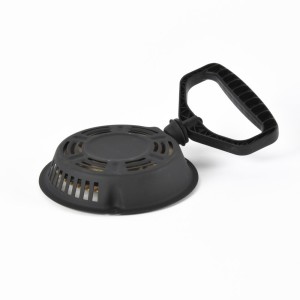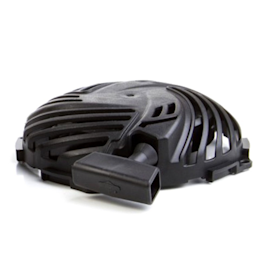How to replace a lawn mower recoil starter on a flathead engine

You can replace the recoil starter on a lawn mower that has a flathead engine by following the DIY instructions in this lawn mower repair guide. The recoil starter, which is riveted to the blower housing on top of the engine, has a spring that retracts the starter rope. If the rope doesn't retract, it's likely the recoil spring is broken. Replacing just the spring is difficult; the best way to repair a recoil starter is to replace the assembly using a manufacturer-approved lawn mower part.
Use these steps to replace the recoil starter on common Briggs & Stratton flathead engines that power Craftsman, Toro, MTD, Murray, Husqvarna, Poulan and Snapper walk-behind lawn mowers.
If your lawn mower is a newer model with an overhead valve (OHV) engine, see our repair guide How to Replace a Lawn Mower Recoil Starter on an OHV Engine.
Instructions
- 01.
Disconnect the spark plug wire
Wear work gloves to protect your hands.
Disconnect the spark wire so there's no chance that the mower could accidentally start.
- 02.
Remove the starter rope from the guide
Remove the starter rope from the rope guide. If the rope won't slip past the guide and the handle, loosen the guide.
- 03.
Remove the engine cover
Remove the screws securing the engine cover to the engine.
Remove the cover.
Slide the rope through the hole in the engine cover.
- 04.
Remove the fuel tank
Remove the screws that secure the fuel tank to the engine.
Lift the tank off, being careful to keep the fuel tank upright so it doesn't leak.
- 05.
Remove the dipstick
Remove the screw that secures the dipstick tube to the housing.
Remove the dipstick from the engine and plug the hole with a paper towel to keep debris from falling into the engine.
- 06.
Remove the engine blower housing
Remove the bolts securing the blower housing to the engine and remove the housing from the engine.
- 07.
Drill out the rivets
Place the blower housing on a firm work surface and remove the mounting hardware that holds the recoil starter assembly in place.
Drill out rivets with a 3/16-inch drill bit.
- 08.
Mount the new recoil starter assembly
Position the new recoil starter assembly onto the blower housing and secure with the hardware provided.
Tip: Insert bolts from the top of the housing. - 09.
Reassemble the mower
Position the engine blower housing on the engine and bolt it into place.
Remove the paper towel from the dipstick opening, slide the dipstick into the engine and secure it with the screw.
Feed the starter rope handle through the engine cover up to the rope guide.
Reinstall the fuel tank.
Position the engine cover on the engine and screw it into place.
- 10.
Reconnect the spark plug wire
Attach the spark plug wire and make sure the mower works properly.
Symptoms for gas walk-behind mowers
Choose a symptom to see related walk-behind mower repairs.
Main causes: damaged cutting blade, loose cutting blade, damaged flywheel key, engine needs tune up…
Main causes: uneven wheel height settings, damaged wheel, dull or damaged cutting blade…
Main causes: engine needs tune up, dirty or clogged carburetor, damaged flywheel key…
Main causes: drive control cable failure, worn or broken drive belt, bad transmission, broken drive wheel…
Main causes: stale gas, engine needs tune up, bad spark plug, dead battery, bad recoil starter, faulty safety switch, ba…
Main causes: dirty carburetor, bad spark plug, clogged air filter, engine choke problems, clogged gas cap vent…
Repair guides for gas walk-behind mowers
These step-by-step repair guides will help you safely fix what’s broken on your walk-behind lawn mower.

How to rebuild a lawn mower carburetor
The carburetor mixes air with fuel to drive the piston. Rebuild the carburetor if it's clogged or leaks.…

How to replace a lawn mower recoil starter on an OHV engine
Replace the recoil starter if it doesn't move when you pull the starter rope.…

How to replace a lawn mower wheel
Learn how replace a damaged wheel on a walk-behind lawn mower—it's a quick, easy fix.…
Effective articles & videos to help repair your walk-behind mowers
Use the advice and tips in these articles and videos to get the most out of your walk-behind lawn mower.

Learn about all the convenient features on our Sears PartsDirect website that make your parts purchases easier.…

Get answers to frequently asked questions about Sears and Sears PartsDirect.…

Learn about the different kinds of mower blades and how to maintain them.…